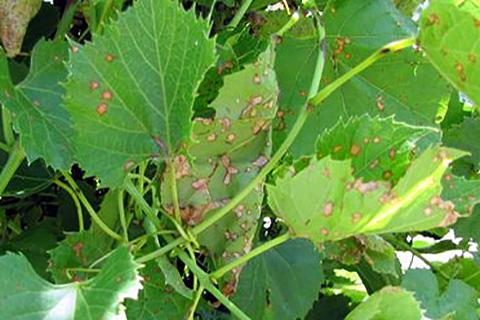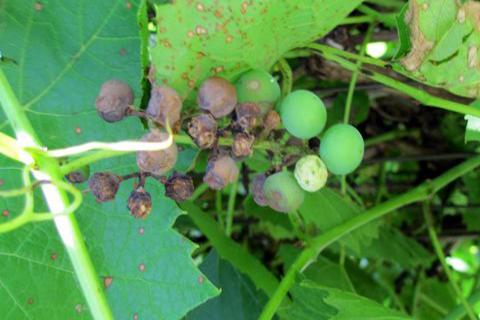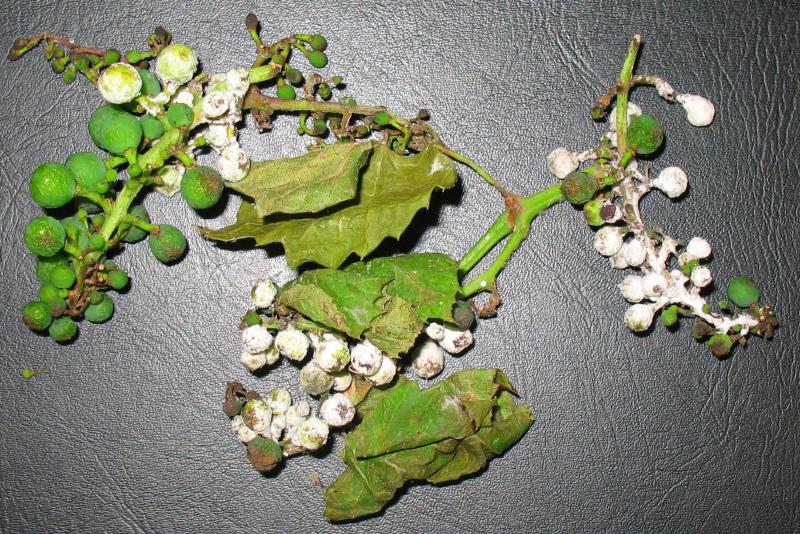Written by Rhoda Burrows, former Professor & SDSU Extension Horticulture Specialist.
In mid-summer, grape growers may notice that all is not well with their fruit clusters, and that some of the berries are rotting. There are several different diseases that can infect the fruit, but two of the most common are black rot and downy mildew. Their symptoms are quite different.
Black Rot

Black rot shows up first as brown leaf spots (Figure 1), generally 1/3 to 1/4 –inch diameter, with dark borders around the lesions. These lesions then produce spores that infect the fruit. Once each leaf is fully expanded, it becomes resistant to new infections. The fruit infection (Figure 2) shows up about when the berries are half-grown, and first appear as small light-brown spots. As the disease progresses, the infected berries rot, and then shrivel into dark mummies which usually stay on the cluster.

Black rot overwinters in cane and tendril lesions, and fruit mummies. The fruit mummies are especially problematic, because they form a type of spore that can travel considerable distances. Therefore, it is extremely important to remove all infected fruit from the vineyard during the winter, if not before. During dormant season pruning, remove canes with lesions, and as much as practical, remove infected tendrils from the trellises. Black rot is favored by warm humid weather, especially during bloom. If only a few leaf lesions appear on the vines, remove those leaves as soon as they are discovered.
Unlike most European varieties of grapes, some of our hardy hybrids have at least some resistance to black rot. ‘Marquette’ is resistant, ‘Valiant’ has slight susceptibility, while ‘Frontenac’ and ‘Brianna’ are moderately susceptible, and ‘LaCrescent’ is quite susceptible.
Downy Mildew

Downy mildew also infects both the leaves and fruit. Leaf symptoms first appear as yellow spots, sometimes described as having an oily appearance. After a period of warm humid nights, a white downy fungal growth appears on the underside of the leaves and other infected tissues. If uncertain about whether the disease is downy mildew, place the infected tissue in a plastic bag with a moistened paper towel and leave overnight. If fresh white downy growth/spores are present the next day, it is downy mildew. If infected soon after bloom, the fruit may, under humid warm conditions, become completely covered with white spores (Figure 3). The fruit become resistant two to three weeks after bloom, although the stalk connecting the fruit cluster to the plant can still become infected and cause the cluster to die.
Downy mildew survives the winter as spores on dead leaves and other decaying tissues, similar to apple scab. If a vine was heavily infected during the growing season, it can help to remove the dead leaves from underneath the vine in the fall. Good pruning and training practices will drastically lower infections in our drier climate. Try to maintain a “curtain” of foliage no more than a couple of leaves thick. (This will also help reduce black rot). As with black rot, cultivars vary in susceptibility to downy mildew: ‘Frontenac’, and to some degree, ‘Marquette’ are resistant, while ‘Valiant’ and ‘LaCrescent’ are susceptible, and ‘Brianna’ is intermediate.
Management
Protective sprays should begin by early June for black rot. There are not very many fungicides labelled for grapes that are readily available to homeowners. One, with the active ingredient myclobutanil, is Immunox Multi-purpose fungicide. It will help control black rot, and should be applied starting when new shoots are just beginning to grow in the spring, and then every two weeks if any disease symptoms are observed on the leaves or fruit. It cannot be used within 14 days of harvest, but application should have ceased by then anyway. Myclobutanil will not control downy mildew.
Mancozeb is another fungicide that is effective for both black rot and downy mildew. However, you cannot use it within 66 days of harvest, which means that for early varieties such as ‘Valiant’ you would not want to spray it after the first week of June. Captan, one of the most commonly available fungicides, and one that controls downy mildew fairly well, has only moderate effectiveness against black rot. Phosphite fungicides such as Agri-Fos, and copper containing fungicides (which can also burn the foliage and fruit) are also effective against downy mildew, but have little effect on black rot. Note that Chlorothalonil-containing fungicides, which are very common for vegetable gardens and ornamentals, cannot be used on grapes.


